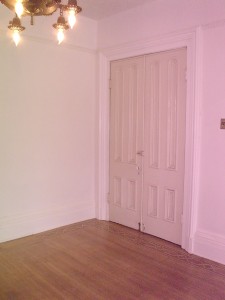
Painted walls and finished floor.
All physical construction work is broken down into parts such as: carpentry, concrete, electrical, flooring and painting to name a few. The same terms used to describe the parts are often used to describe the trade responsible for executing the construction of that part. Each construction trade’s work is unique. For the vast majority of trade work, the labor must be completed by the specific tradesman. You can’t have a painter install flooring and you can’t have a carpenter run the electricity. However, there are tasks between trades that often overlap and can be handled by either of the involved trades.
Here is a simplified example of overlapping tasks:
Let’s say that you want to get the floor replaced in your house, and you want the house interior painted too. The flooring company installs the floor but can’t do any painting. The painting company will paint everything, but cannot install any flooring, baseboard or quarter-round.
The kind of existing floor you have, determines whether you currently have quarter-round (or base-shoe) in place. It is often less expensive to install new quarter-round than to remove, restore and reinstall the existing quarter-round. For this reason, flooring companies often furnish new quarter-round, if it is needed to ‘finish’ the flooring installation. Sometimes the furnished quarter-round is already color coordinated to match the flooring. Sometimes the quarter-round needs painting to match the walls, and sometimes you get the choice.
You can have the house painted, and then have the floor installed, but who paints the quarter-round after the flooring people install it? You can have the flooring people install the floor and quarter-round before the painters paint, but what happens if the painters damage or get paint all over the new floor while painting? What should you do first? How do you coordinate the work between the trades in order to ensure nothing is messed up or missed?
The best approach is to work with the contractors to schedule the coordinated work between the two tradesmen. Here is a simplified example of how that can work:
If the new quarter-round is designed to match the floor, whether or not the old floor has quarter-round, coordination is really easy. Just have the painters come in and paint then have the flooring installers come in afterward to remove the old quarter-round if neccessary and install the new floor and quarter-round afterward.
If the new floor needs no new quarter-round and the old floor has quarter-round, then include the removal of the old quarter-round as part of the painting prep-work. Then have the painters’ paint before having the flooring people install the new floor.
If the quarter-round needs to be painted, getting everything done requires a little more coordination. Include the painting of the new quarter-round in the painters’ contractual scope of work, this way it won’t add any extra cost to the project later. Ask the flooring company to furnish or let you pick up all the quarter-round in advance. Installers often deliver materials in advance to give the materials time to acclimate to the space’s temperature and humidity level before installation, so getting the quarter-round in advance shouldn’t be a problem. This way you can have the painters’ paint the quarter-round while on site for a cost that has already been negotiated.
Have the painters paint before the flooring installation. The painters should protect all of the furniture and paint as contracted. You won’t have to worry much about the floor if you are replacing it anyway. Once the quarter-round is painted and the paint is dry, have the painters set the quarter-round aside.
Coordinate the work so that when the painting company is finished painting the space and the quarter-round, the flooring company can come in the next day (or shortly thereafter) to install the flooring and the painted quarter-round.
Using this sequence ensures that after the floor installation, all that could be left is a tiny bit of touch up painting at the quarter-round nail holes and cut marks. After the floor installation, if the painters need to come back to the site to paint elsewhere, you can have them touch up the quarter-round as needed. However, if the painters have already completed all their work it will cost more to have the painters come back to do the touch up painting. In this case it is more cost effective to include the touch up painting in the flooring company’s contract scope of work, or handle that ‘tiny’ bit yourself like a GC might do.
For each trade that you add it becomes a bit more complicated to coordinate the individual company’s work. In addition, each project and contractor is unique. Some contractors may be willing to take on more work, while others less. It’s important to coordinate the work during the bidding process, in order to make sure that you don’t pay twice to have the same task completed, or become a captive audience during construction because you forgot to include specific tasks.